How to choose suitable home lighting?
Introduction to Spotlights
Spotlights, also known as recessed lights or can lights, are a type of ceiling lighting fixture designed to direct light downwards in a focused beam. They are typically installed flush with the ceiling, providing a clean and minimalist look to the room. Spotlights have gained popularity due to their versatility, energy efficiency, and ability to enhance the aesthetics of various spaces.

Characteristics of Spotlights

Light Direction and Beam Angles
Spotlights are designed to emit a narrow, focused beam of light downwards, usually with beam angles ranging from 30 to 120 degrees. This focused light is ideal for highlighting specific areas or objects in a room, such as artwork, architectural features, or task areas like kitchen countertops.
Types of Bulbs Used
Modern spotlights predominantly use LED (Light Emitting Diode) technology due to its energy efficiency, long lifespan, and design flexibility. LED spotlights consume less energy and produce minimal heat compared to traditional incandescent or halogen bulbs. They are available in various color temperatures, ranging from warm white to cool daylight, catering to different lighting preferences and room atmospheres.
Installation and Integration
Installing spotlights involves recessing the fixture into the ceiling, which requires cutting holes of specific sizes to accommodate the fixtures. This installation method ensures that spotlights are flush with the ceiling surface, reducing visual clutter and maintaining a streamlined appearance. However, this process may require professional installation, especially in ceilings with insulation or structural considerations.
Design Versatility
Spotlights come in various designs and sizes to suit different interior styles and lighting needs. They can be adjustable or fixed, allowing for flexibility in directing light precisely where needed. Adjustable spotlights are particularly useful for changing room layouts or highlighting different areas over time.
Applications and Uses
Spotlights are commonly used in residential and commercial settings for both functional and decorative purposes. In homes, they are often installed in kitchens, living rooms, hallways, and bathrooms to provide task lighting or accentuate specific design elements. In commercial spaces, spotlights are used in retail stores, galleries, museums, and hospitality venues to highlight products, artworks, or architectural details.
Comparison with Other Ceiling Lighting Options
1. Chandeliers and Pendant Lights
Light Distribution: Chandeliers and pendant lights typically emit light in all directions, illuminating a larger area compared to spotlights. They are often used as focal points or decorative elements in dining rooms, entryways, or living spaces where a more dispersed light distribution is desired.
Visual Impact: Unlike spotlights, which are recessed into the ceiling, chandeliers and pendant lights hang visibly and can contribute to the overall decor and style of a room. They come in various designs, materials, and sizes, serving both functional and aesthetic purposes.
2. Flush Mount and Semi-Flush Mount Ceiling Lights
Installation and Design: Flush mount and semi-flush mount ceiling lights are fixed directly onto the ceiling surface without protruding significantly. They provide general ambient lighting and are suitable for rooms with lower ceilings where space is limited.
Lighting Effect: Unlike spotlights, which create a spotlight effect, flush mount and semi-flush mount lights distribute light more evenly across the ceiling and room. They are versatile options for providing overall illumination while blending seamlessly into various interior styles.
3. Track Lighting Systems
Adjustability and Flexibility: Track lighting systems consist of multiple adjustable light fixtures mounted on a track, allowing for flexible positioning and direction of light. They are suitable for highlighting specific areas or creating focal points in larger spaces.
Installation and Customization: Track lighting systems require mounting tracks on the ceiling or walls, offering versatility in lighting layout and design. They can be adjusted to direct light towards different areas as needed, making them ideal for dynamic lighting arrangements in kitchens, galleries, or retail spaces.
4. Recessed Downlights and Downlight Kits
Similarities to Spotlights: Recessed downlights share similarities with spotlights as they are installed flush with the ceiling, providing focused downward lighting. They are available in various sizes and designs, offering options for different lighting applications and room sizes.
Application Differences: While spotlights are generally used for accent lighting or task lighting, recessed downlights are often used for general ambient lighting in residential and commercial settings. They provide a clean and unobtrusive lighting solution, contributing to a modern and minimalist interior design.

Considerations for Choosing Spotlights or Other Ceiling Lighting Options
Room Size and Ceiling Height: Spotlights are suitable for rooms with lower ceilings where overhead space is limited. They provide efficient lighting without occupying visual space, making them ideal for compact living areas or corridors.
Lighting Requirements: Consider the specific lighting needs of each room, such as task lighting in kitchens or reading areas, ambient lighting in living rooms or bedrooms, or accent lighting for highlighting artworks or architectural features.
Interior Design and Style: Choose lighting fixtures that complement the overall decor and style of the room. Spotlights offer a modern and minimalist aesthetic, while other ceiling lighting options like chandeliers or pendant lights can add a decorative element or focal point to the space.
Energy Efficiency and Sustainability: LED spotlights are preferred for their energy-saving benefits and reduced maintenance costs compared to traditional lighting technologies. Consider the long-term energy efficiency and environmental impact when selecting lighting fixtures for residential or commercial spaces.
Installation and Maintenance: Evaluate the installation requirements and maintenance considerations of each lighting option. Spotlights may require professional installation due to their recessed design, whereas other ceiling lighting fixtures may offer easier installation and replacement options.
Conclusion
In conclusion, spotlights are versatile and efficient lighting fixtures suitable for accent lighting, task lighting, or creating focal points in residential and commercial spaces. They offer a modern and streamlined aesthetic while providing focused illumination where needed. When choosing between spotlights and other ceiling lighting options, consider the specific lighting requirements, interior design preferences, and functionality of each room to achieve optimal lighting solutions and enhance the overall ambiance of the space.
